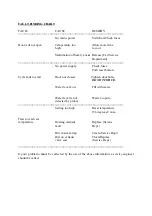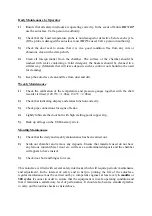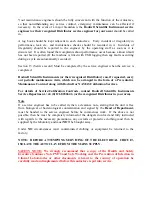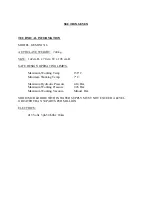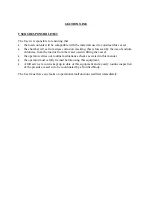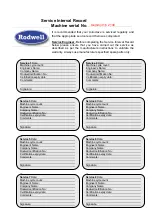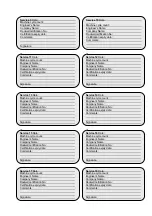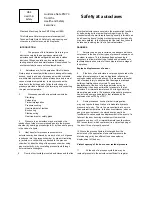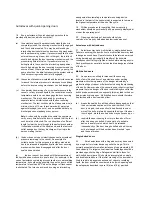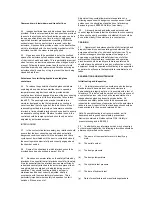
Plant and Machinery Series PM73 (August 1990)
This Guidance Note incorporates relevant parts of
Technical Data Note 46
Safety at quick-opening and
other doors of autoclaves,
which it replaces.
INTRODUCTION
1
The purpose of this Guidance Note is to give
advice concerning the dangers associated with
autoclaves and related safeguards and also includes
advice on fittings, operation and operator training,
testing, examination and maintenance. Vessels used for
exothermic reactions are not considered here.
2
Autoclaves are, for the purpose of this Guidance
Note. pressure vessels with lids or doors arranged for ready
access, used in a variety of processes in which materials
are subjected to pressure above atmospheric and in most
cases elevated temperatures. In many processes the
variation in the boiling point of a liquid with change in
pressure provides a method of determining and controlling
the process temperature.
3
Processes carried out in autoclaves include:
Sterilising
Vulcanising
Timber impregnation
Pressure cooking
Heat treatment of textiles
Brick curing
Plastics curing
Heat treatment of safety glass
4
Pressure in an autoclave may be raised by the
introduction of steam or compressed gas into the process
chamber, by heating a process liquid, or by the use of a pump
in the case of a liquid.
5
Heat transfer for process requirements in
autoclaves may be achieved by steam, hot air, or hot gases
introduced into the process chamber,
by steam circulating
in jackets or in coils within or attached to the process
chamber, by direct heating of the process chamber using
gas or electricity, or by circulating process liquid through
external heat exchangers.
6
Door/s of horizontally mounted autoclaves and the lids
of vertical autoclaves are secured in the pressure tight position
by bolts, swing bolts or swivelling locking stirrups, or by a
mechanism which permits rapid opening, usually referred to as
'quick-opening doors'; locking mechanisms may be manually
or power operated. In the following text the term 'door' should
be taken as including the
lid
of a vertical autoclave. "
DANGERS
7
Autoclaves give rise to certain extra dangers which are
not present in the use of other types of pressure vessels, such
as steam receivers. This is because frequent opening is
necessary to allow material to be loaded and unloaded or to
facilitate examination or test of the contents at some stage of
the process.
Explosive displacement of a door
8
If the door of an autoclave is not properly secured while
under internal pressure, it may be displaced, allowing an
explosive release of stored energy. This presents a potential
risk of serious injury to people and of damage to plant and
buildings; fatalities have occurred. The explosive
displacement of the door of a large autoclave may be
devastating; it has been estimated, for example, that an
autoclave 2 m internal diameter and 22 m long containing
steam at approximately 15 bar above atmospheric pressure,
has a stored energy equivalent to that released by the
explosion of about 32 kg of TNT.
9
Some processes, such as timber impregnation,
may only require the application of a moderate hydraulic
pressure up to, say, 7 bar to the process liquid, at no more
than ambient temperature. In these circumstances, when no
gas or vapour is present, the stored energy would be
insufficient to cause explosive displacement in the event of a
failure of the door securing mechanism. However this
pressure on a door of 2 m internal diameter would produce
225 tonnes thrust, which could result in a violent opening of
the door if it is not properly secured.
10 Where the process liquid is discharged from the
autoclave by the application of pneumatic pressure the
stored energy may be sufficient to cause explosive
displacement of the door.
Violent opening of the door under residual pressure
11
At the end of a process cycle there may be
residual pressure in the autoclave insufficient to register
HSE
Health
&
Safety
i
Guidance
Note
PM
73
from
the
Health
and
Safety
Executive
Safety
at
autoclaves

